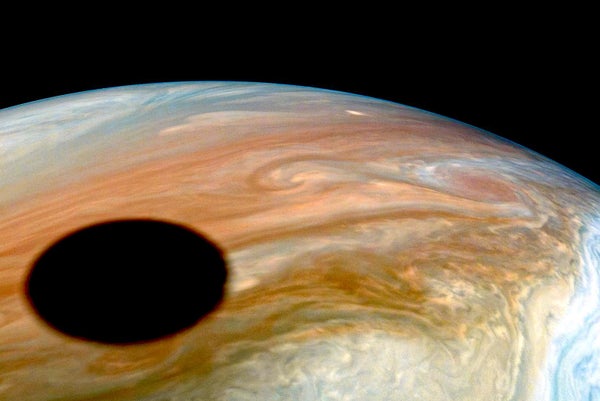This article was published in Scientific American’s former blog network and reflects the views of the author, not necessarily those of Scientific American
This Monday, November 11th, from 7.35 a.m. (Eastern Standard Time) to 1.04 p.m. the planet Mercury will make its way across the disk of the Sun from the perspective of all Earth-bound observers. It’s an alignment that happens in a very predictable way—albeit within a somewhat complicated series of time intervals—and only ever in the months of May or November. For instance, the next transit like the one in November 2019 will happen in exactly 13 years’ time.
Another celestial alignment is brewing too. That’s the conjunction of the planets Jupiter and Saturn in December of 2020. At that point they’ll appear as close together on the sky as they ever do—a once-every-twenty-years event. Already, in 2019, these two giant worlds are beginning to draw together on our skies as their orbits (with a period of 11.8 years for Jupiter, 29.5 years for Saturn) place them into alignment from our perspective.
Even though most of our species (I hope) have moved beyond mysticism and the divination of nature, we still get excited by these events. Partly because these are interesting phenomena to look at—with an aesthetic appeal—but perhaps also because some part of our psyche gets a little fluffing. Even with a complete grasp of the scientific facts it’s nice to feel a teeny bit of cosmic privilege now and then.
On supporting science journalism
If you're enjoying this article, consider supporting our award-winning journalism by subscribing. By purchasing a subscription you are helping to ensure the future of impactful stories about the discoveries and ideas shaping our world today.
But the really interesting thing is how these apparently clockwork-like events can inspire a deeper dive into the specifics of the architecture of our solar system that are far more complex. A dive that leads to clues about very real, very profound effects on the nature of the environment that life on Earth experiences across tens of thousands, and millions, of years.
All planets have mass, and all mass exerts a gravitational force. In Newtonian physics that force is a somewhat mysterious thing, in Einstein’s physics it is a consequence of mass distorting the fabric of space and time around itself. Consequently, every object in our solar system tugs at every other object. But some do more than others. Our Sun is obviously the biggest gravitational beast, with a mass of some 330,000 Earths. But Jupiter is next in line, at 317 times the mass of Earth—or about 70% of the total mass of all the major planets.
Because of this, Jupiter (with Saturn next in status) has by far and away the greatest influence on the long-term orbital behavior of the other worlds, Earth included. To see how this can play out it helps to imagine how Jupiter and Earth are positioned relative to each other: In the time it takes Jupiter to orbit once around the Sun, Earth will have buzzed around nearly 12 times. This means that once a year we feel a maximum pull towards Jupiter, and the direction of that pull only changes a modest amount year by year (by thirty degrees roughly). As a result, Jupiter is like a nagging ache imposed on our orbit, persistently dragging it.
As a result (together with the pull of Saturn and all the other worlds), the shape, or ellipticity of Earth’s orbit, and its orientation in space, gradually oscillates and shifts. These ellipticity variations end up being a combination of changes of different periods—a bit like playing three musical notes on top of each other—with the most noticeable ‘pulse’ clocking in at around 100,000 years.
There are other gravity-induced effects too. The tilt of Earth’s orbital plane also oscillates up and down by a tiny amount over roughly 100,000-year timespans. This, together with tidal forces of the Sun and Moon, leads to Earth’s spin axis both wiggling back and forth by a couple of degrees over 41,000 years, but also changing its direction, or precessing. For example, in some 13,000 years that change will result in our north pole being tilted towards the Sun at our closest distance to the Sun (at our perihelion point in our elliptical orbit). That’s the opposite of what happens today, when we actually experience northern winter when Earth is closer to the Sun.
All of these effects are well known, and usually bundled together as the Milankovitch Cycles—the climate influencing variations that the Serbian geophysicist and astronomer Milutin Milanković first recognized in the 1920s. They impact climate because these slow alterations in Earth’s configuration change the fundamentals of solar radiation hitting the planet. Consequently, they correlate with global and regional temperature shifts that we see recorded in ice and rock across the planet during at least the past few million years. And that includes climate changes like the ice ages and wet-dry cycles that overlap with the existence of anatomically modern humans and their dispersal across the globe.
So, when you see events like Mercury’s transit, or the conjunction of Jupiter and Saturn in our skies, you are actually bearing witness to a tiny moment in a grand gravitational dance. Even if performed with fingertips barely touching across the void, that dance is enough to quite literally transform the history of life on Earth.
